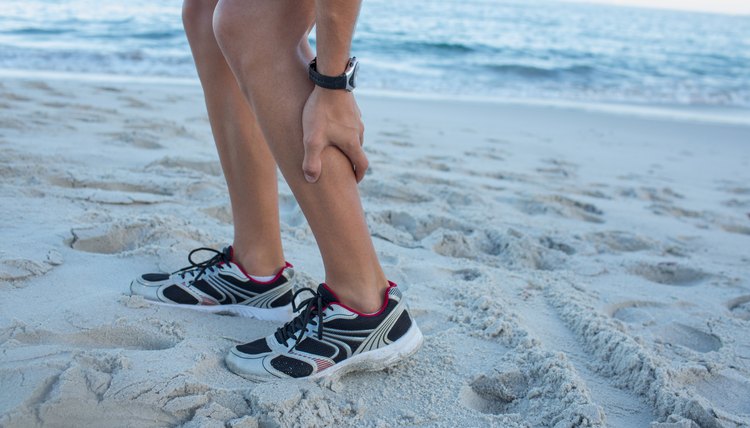Quick Ways to Get Over a Pulled Muscle

Many common ailments, such as cramping, get confused with muscle strains, warns registered massage therapist Paul Ingraham. The difference with a pulled muscle, also known as a muscle strain, is that you feel it immediately after exercising and it affects just one muscle. If you suffer from a pulled muscle, topical and dietary remedies can speed up your recovery, although specific recovery times vary depending on the muscles affected and the severity of your strain.
Hold 'Em High
If the sore area where you've strained a muscle appears inflamed, flushed, red or swollen, elevate it immediately. This helps reduce the rush of blood and fluids to the area and minimizes overall swelling. Elevation is one of the first steps in the RICE method -- rest, ice, compression and elevation -- that the National Institute of Arthritis and Musculoskeletal and Skin Diseases says will immediately help to "relieve pain...and speed healing." For example, if you've strained a muscle in your forearm, hold it up with your opposite arm or use an arm sling. Prop the injured muscle on sleeping pillows or similar objects while you are lying down.
Apply Ice
Cryotherapy, the fancy term personal trainers use to refer to putting ice on an injury, helps with all kinds of muscle soreness. Cold therapy should get applied to your muscle strain as soon as possible after you notice you've hurt yourself. The Association of Ringside Physicians recommends wrapping an ice pack or bag of ice in a towel and holding it to your pulled muscle for 10 minutes every three hours. Continue doing this for three days. Cold therapy reduces nerve activity, thus helping to minimize pain in the area. It also improves the range of motion in your injured muscle.
Take a Break
Your body requires rest to help repair torn or strained muscle tissue. Avoid exercising the area around your pulled muscle until you're able to do movements with no sensation of pain. Exercising while your muscle is pulled or strained increases your risk of injury. It may also reduce the rate at which your injured limb heals.
Eat the Right Food
Your doctor may prescribe various pain medications for a pulled muscle, but try prescribing a healthy diet to yourself. Several specific foods can help with muscle pain and muscle recovery, according to a column by registered dietitian and certified personal trainer Gina Crome for the American Council on Exercise. For example, try snacking on cherries. Cherries contain antioxidants that help fight inflammation. Or, try some watermelon, which is rich in the L-citrulline amino acid that helps increase blood flow and may help to reduce muscle pain.
References
- PhysioWorks Australia: Muscle Pain
- American Council on Exercise: What Causes Muscle Soreness and How is it Best Relieved?
- American Council on Exercise: If My Muscles are Sore from Previous Workouts, is it Safe to Exercise Them?
- American Council on Exercise: Foods That Fight Muscle Soreness
- National Institute of Arthritis and Musculoskeletal and Skin Diseases: What Are Sports Injuries?
Writer Bio
Joshua Duvauchelle is a certified personal trainer and health journalist, relationships expert and gardening specialist. His articles and advice have appeared in dozens of magazines, including exercise workouts in Shape, relationship guides for Alive and lifestyle tips for Lifehacker. In his spare time, he enjoys yoga and urban patio gardening.
